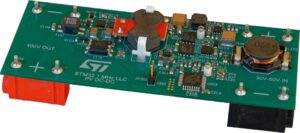As more engineers work on photovoltaic solutions, our B-G474E-DPOW1 Discovery kit, with its STM32G474, can help them design better solar inverters. Just like the STM32F334, this MCU integrates high-resolution timers to offer tighter voltage regulations. Photovoltaic systems harness solar power and convert it into usable electrical energy. They rest on three major elements: power generation (1), power load (2), and the balance of system or BOS (3). Power generation is the arrays of solar panels where photons knock out free electrons to generate DC electricity. The power load is the alternating current that powers devices in homes, factories, etc. The BOS is the infrastructure that sits between the solar panels and load. It includes the wiring, battery banks, battery chargers, and, among other things, the power converters that will be at the center of this blog post.
[pretty-callout align=”right”]Fun Facts
- The sun emits 384.6 yotta watts (3.846×1026 watts) of energy
- The light and radiation that reach our planet produce about 1 kW/m2
- The state of Texas receives enough solar energy to produce 300 times more power than all of the world’s electrical plants combined (source: University of Tennessee)
Photovoltaic Converters: How to Deal with their Many Challenges?
Solar converters are the heart of any photovoltaic system, but they are also particularly challenging to design because of the extreme conditions they must weather. The most apparent risk is overheating, as it is not always possible to shield it from high temperatures. Similarly, as inverters are often outdoors, they ought to be compatible with high humidity and cold environments. They must also deal with significant voltage variations. As multiple rows of solar panels try to capture sunlight, they will not all have identical exposures, nor will the exposure be constant. An efficient power converter is one that generates as little energy loss as possible regardless of the weather or time of day. Finally, power inverters must be inexpensive, or solar power will never penetrate mainstream markets and reach critical mass.

Recently, an answer to these challenges came in the form of MPPT solar converters. Maximum Power Point Tracking is a technique that maximizes the power that the solar panels can put out by continuously tracking the converter’s input power. By adapting its input characteristics (impedance) the panel stays at peak power operating point, regardless of the levels of solar radiation or the panel’s temperature. Simply put, because the output characteristics of solar cells aren’t linear, the MPPT inverter monitors the power generation and, with the help of algorithms, changes its behavior to extract as much power from the solar panels as possible. And to implement the various MPPT strategies that will maximize the power load, the solar converter has to use flexible devices that can adjust to these changes, such as our STM32F334 or STM32G474 MCUs that embark high-resolution timers (HRTIM1).
Photovoltaic Converters: What Are the Benefits of High-Resolution Timers?
Analog converters tend to hover around a few 100 kHz, which limits the converter’s compactness since a lower switching frequency means bulkier passive components such as magnetics and capacitors. Engineers, therefore, turn to microcontrollers, but these digital devices still need high-resolution timers. In a standard MCU running at 100 MHz, generating a 1 MHz Pulse Width Modulation means that each PWM steps will take ten nanoseconds. The STM32G474 uses a timer with a resolution of 184 picoseconds, which corresponds to a frequency of approximately 5 GHz, thus increasing the overall precision by a factor of 50, and the STM32F334 isn’t far behind at 217 picoseconds. Such performance allows for much tighter control of the output voltage and current, as well as a far better response to load transients. In short, a high-resolution timer offers the flexibility that MPPT converters require.

The margins afforded by high-resolution timers enable the use of more cost-effective passive components, such as windings with lower inductance. Indeed, the increase in performance dramatically reduces switching losses. As a result, designers can choose parts with less headroom since there will be fewer variations in voltage or current. Similarly, they can also use more cost-effective ceramic capacitors. Engineers traditionally needed to use electrolytic capacitors in solar inverters. However, the BOS must work in very high temperatures, and getting electrolytic capacitors compatible with this kind of environment is expensive. Additionally, leaks due to aging will often compromise the whole system and force companies to replace the entire inverter. High-resolution timers allow for the use of ceramic capacitors, which bypass all these issues and can significantly drive down the initial and maintenance costs.
Looking Forward to SiC and GAN in LLC Resonant Topologies
The advantages of MCUs with high-resolution timers also extend far beyond MPPT solar converters to benefit other LLC resonant topologies which are now popular in power supplies for consumer electronics, industrial applications, server farms, and many more. By using an inductance (L) and one capacitor (C), it is possible to generate a resonance at slightly below the switching frequency, which will enable zero or near zero voltage switching, thus significantly reducing losses. Switching transistors are susceptible to losses, but if the switching takes place when the voltage is at zero or close, losses become insignificant. This topology thus dramatically benefits from a digital controller to rapidly respond to load changes.
Moreover, many are looking at the advent of Silicon Carbide devices and wonder how they will drive these devices. They offer great performances, but regular timers are just inadequate. The answer is the high-resolution timers of the STM32F334 and STM32G474, which enable not only more precise LLC topologies, but also more modern systems with SiC or even Gallium Nitride (GAN) devices. Companies tend to overlook this fact because not many boarded the SiC or GAN train yet, but it means they can start certifying these MCUs now and use them for the years to come knowing they are already capable of welcoming the next breakthroughs in electronics.
How to Build a Digital MPPT Solar Converter
To help engineers design their digital MPPT solar converter, we published, on our Community platform, the design files (Altium), manufacturing files, and the software project to import into STM32CubeMX. They will go a long way to solve some of the most challenging aspects of this system and can serve as a great starting point or test platform to teams looking to develop their inverters. It also demonstrates how high-resolution timers ensure the use of smaller and more reliable components for a compact design and an efficiency above 90 % over a wide power range. The converter operates at 1 MHz and uses the HRTIM1 high-resolution timer of the STM32F334, but given the open source nature of the project, anyone can update it to use an STM32G474, for instance.
- Download the 1MHz LLC PV DC-DC board design
- Learn more about the STM32G474
- Check out the STM32F334
- Create a prototype with the B-G474E-DPOW1 Discovery kit
